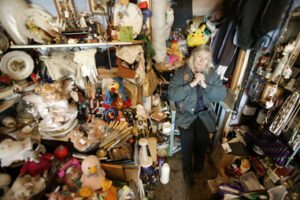
HOARDING OCD AND ITS TREATMENT WITHOUT MEDICINE, OCD AND HOARDING
Hoarding OCD is a mental health condition where a person finds it extremely difficult to throw away or give up possessions, even when those items have no real use or value. This is not the same as simply being messy or disorganized. It involves deep emotional discomfort when trying to get rid of things, often leading to cluttered and unmanageable living spaces.
Someone with hoarding OCD may collect all sorts of things—such as worn-out clothes, broken electronics, empty boxes, old newspapers, or spoiled food. These items may pile up over time, taking over bedrooms, kitchens, hallways, or even bathrooms. The thought of removing or cleaning up these items often causes intense stress, sadness, or even anger. Many people with this condition strongly resist any changes to their environment, especially if others try to clean or organize for them.
Signs and Behaviors to Watch For
Recognizing hoarding OCD early is important, as it can worsen over time. Here are some signs that may indicate a person is struggling with this condition:
- Feeling embarrassed about the state of your home, but still feeling unable to change it.
- Holding onto items “just in case”, even when there’s no realistic need for them.
- Living in a cluttered or unsafe space, where furniture, sinks, or appliances can’t be used properly.
- Getting very upset or anxious when someone suggests throwing things away.
- Putting off organizing or cleaning tasks because it feels too overwhelming or stressful.
These behaviors don’t happen out of laziness or lack of care. Instead, they come from a deep fear of losing something important, making a wrong decision, or feeling regret later.
Thought Patterns in Hoarding OCD
Many people with hoarding OCD experience repetitive, intrusive thoughts that feed their behavior. These thoughts might include:
- “I might need this one day.”
- “What if I throw it away and regret it later?”
- “This object means something to me, even if others don’t see it.”
- “I have to keep this because someone gave it to me.”
- “Getting rid of things makes me feel like I’m losing a part of myself.”
These thoughts can cause emotional pain and fear, making it feel safer to hold on to everything—even if it leads to discomfort or chaos.
Actions That Result From These Thoughts
To try to reduce the anxiety caused by their thoughts, people with hoarding OCD often carry out certain behaviors repeatedly. These may include:
- Checking and re-checking items, making sure nothing is moved or lost.
- Reorganizing, sorting, or stacking things, without ever getting rid of anything.
- Saving broken or non-working items, just in case they might be fixed or needed.
- Cleaning often, but only moving things from one place to another rather than actually clearing them out.
- Avoiding letting anyone touch their belongings, even when help is offered.
- Bringing home more items, even if they already have too much and no space left.
Over time, these habits make daily life harder. Simple things like cooking, sleeping, or moving around the home can become difficult or even dangerous.
Why It’s Important to Get Help
Hoarding OCD is not just about keeping stuff—it’s about fear, emotion, and the difficulty of letting go. It can lead to isolation, health issues, and problems with family or neighbors. Older adults are more likely to struggle with hoarding, but it can affect anyone, regardless of age or background.
It’s important to understand that things are meant to be useful, not stressful. Carrying too much—physically and emotionally—can wear us down. Letting go of what no longer helps us can create space for clarity, peace, and healthier living.
For any question write to us info@emotionoflife.in or reach out to us via call 9368503416 or visit or website- www.emotionoflife.in
